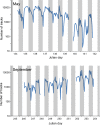Evaluating the Effectiveness of Wildlife Detection and Observation Technologies at a Solar Power Tower Facility
- PMID: 27462989
- PMCID: PMC4963080
- DOI: 10.1371/journal.pone.0158115
Evaluating the Effectiveness of Wildlife Detection and Observation Technologies at a Solar Power Tower Facility
Abstract
Solar power towers produce electrical energy from sunlight at an industrial scale. Little is known about the effects of this technology on flying animals and few methods exist for automatically detecting or observing wildlife at solar towers and other tall anthropogenic structures. Smoking objects are sometimes observed co-occurring with reflected, concentrated light ("solar flux") in the airspace around solar towers, but the identity and origins of such objects can be difficult to determine. In this observational pilot study at the world's largest solar tower facility, we assessed the efficacy of using radar, surveillance video, and insect trapping to detect and observe animals flying near the towers. During site visits in May and September 2014, we monitored the airspace surrounding towers and observed insects, birds, and bats under a variety of environmental and operational conditions. We detected and broadly differentiated animals or objects moving through the airspace generally using radar and near solar towers using several video imaging methods. Video revealed what appeared to be mostly small insects burning in the solar flux. Also, we occasionally detected birds flying in the solar flux but could not accurately identify birds to species or the types of insects and small objects composing the vast majority of smoking targets. Insect trapping on the ground was somewhat effective at sampling smaller insects around the tower, and presence and abundance of insects in the traps generally trended with radar and video observations. Traps did not tend to sample the larger insects we sometimes observed flying in the solar flux or found dead on the ground beneath the towers. Some of the methods we tested (e.g., video surveillance) could be further assessed and potentially used to automatically detect and observe flying animals in the vicinity of solar towers to advance understanding about their effects on wildlife.
Conflict of interest statement
Figures









Similar articles
-
An effective survey method for studying volant species activity and behavior at tall structures.PeerJ. 2020 Feb 12;8:e8438. doi: 10.7717/peerj.8438. eCollection 2020. PeerJ. 2020. PMID: 32095329 Free PMC article.
-
Regional representativeness assessment and improvement of eddy flux observations in China.Sci Total Environ. 2015 Jan 1;502:688-98. doi: 10.1016/j.scitotenv.2014.09.073. Epub 2014 Oct 10. Sci Total Environ. 2015. PMID: 25310829
-
Field testing an "acoustic lighthouse": Combined acoustic and visual cues provide a multimodal solution that reduces avian collision risk with tall human-made structures.PLoS One. 2021 Apr 28;16(4):e0249826. doi: 10.1371/journal.pone.0249826. eCollection 2021. PLoS One. 2021. PMID: 33909647 Free PMC article.
-
Challenges and prospects in the telemetry of insects.Biol Rev Camb Philos Soc. 2014 Aug;89(3):511-30. doi: 10.1111/brv.12065. Epub 2013 Oct 8. Biol Rev Camb Philos Soc. 2014. PMID: 24106908 Review.
-
Why are there so many insect species? Perspectives from fossils and phylogenies.Biol Rev Camb Philos Soc. 2007 Aug;82(3):425-54. doi: 10.1111/j.1469-185X.2007.00018.x. Biol Rev Camb Philos Soc. 2007. PMID: 17624962 Review.
Cited by
-
SPATIAL DEMOGRAPHIC MODELS TO INFORM CONSERVATION PLANNING OF GOLDEN EAGLES IN RENEWABLE ENERGY LANDSCAPES.J Raptor Res. 2017 Sep;51(3):234-257. doi: 10.3356/JRR-16-77.1. J Raptor Res. 2017. PMID: 30220786 Free PMC article.
References
-
- McCrary MD, McKernan RL, Schreiber RW, Wagner WD, Sciarrotta TC. Avian mortality at a solar energy power plant. J Field Ornithol. 1986;57: 135–141.
-
- HT Harvey & Associates. Ivanpah Solar Electric Generating System Avian & Bat Monitoring Plan—2013–2014 Annual Report Nipton, CA: HT Harvey & Associates.
-
- Taylor P. Bird deaths at Calif. power plant a PR nightmare for industry. Environment & Energy Publishing, 19 Jan 2015. Available: http://www.eenews.net/greenwire/stories/1060011853. Accessed 18 May 2015.
-
- Larkin RP, Frase BA. Circular paths of birds flying near a broadcasting tower in cloud. J Comp Psychol. 1988;102: 90–93.
MeSH terms
LinkOut - more resources
Full Text Sources
Other Literature Sources

